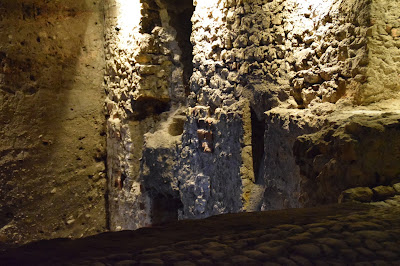An archaeological reserve unique in Europe, covering nearly 4000 sq.m
(43,000 sq.ft), was fashioned under the surface of the Main Market
Square to provide a display for the treasures that had been found and
narrate the turbulent history of Medieval Kraków.
The tourist route under the Main Market Square leads between the stone
and brick walls of the cellars of former trading sites, including the
Kramy Bolesławowe Stalls, Kramy Bogate Stalls, the Great Scales, and the
Cloth Hall. Another curio is the preserved stretches of transport
routes, which provide an idea of what the mediaeval technology of road
building was. The untouched layers in archaeological section explain how
the surface of the Main Market Square has risen over the last few
hundred years.
Numerous objects make it possible to imagine daily life in Kraków a few
centuries ago. The exhibition shows, among others, mediaeval tools,
historical coins, clay figures, decorations, dice and toiletry articles
used over 600 years ago, together with the Tartar arrowheads, and beads
and medallions from the Orient. Especially commanding is the slab of
lead – a highly precious metal at the time – weighing 693 kg (1528 lb),
the only such item in the world, locally known as a “loaf”. Visiting the
tourist route in the Rynek Underground, one can also become familiar
with the history of Kraków from before the foundation of the city. The
oldest history of the site is exemplified by reconstructions of
11th-century burials presented in the exhibition. A picture of the
pre-charter settlement destroyed during the Tartar raid of 1241 emerges
from the original foundations of cottages from the late 12th and early
13th century, and reconstructions of goldsmith’s and blacksmith’s
workshops.



















No comments:
Post a Comment